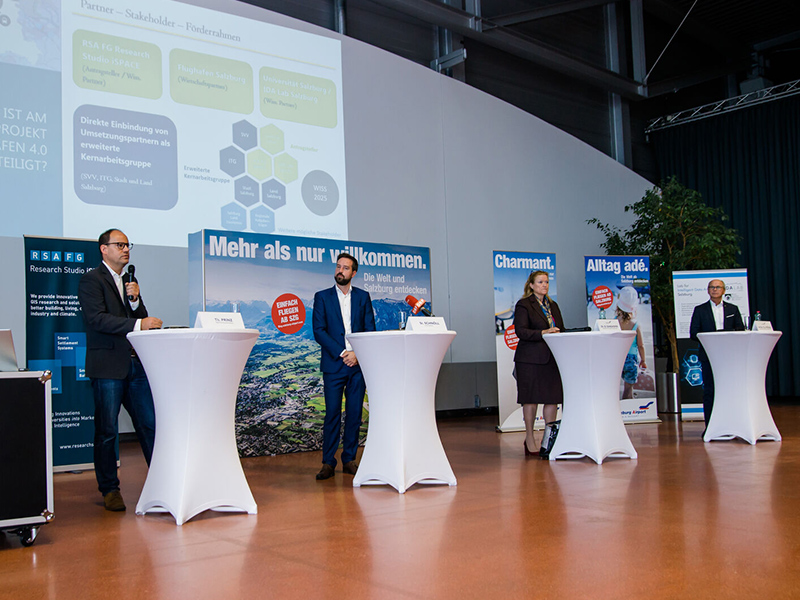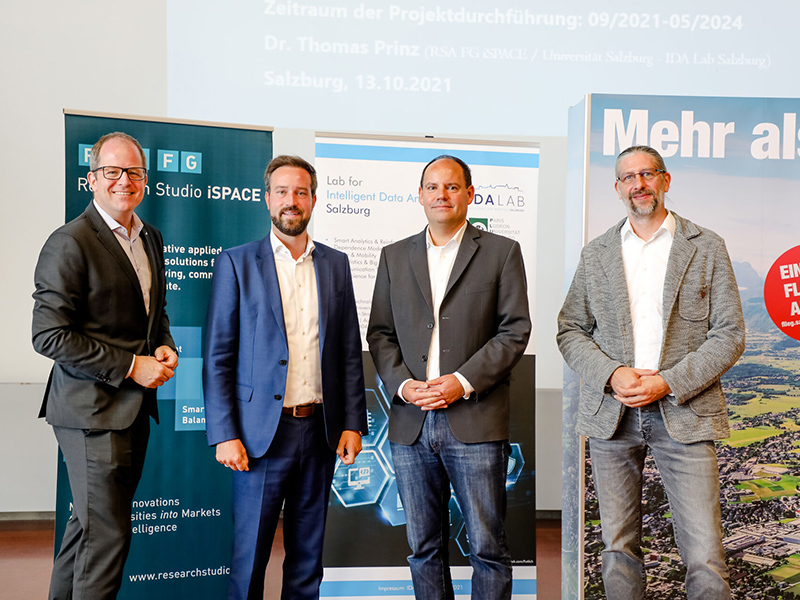Salzburg Airport is an important economic driver, but it is not very well integrated into the everyday transport system of the surrounding area. The project “Airport 4.0” is now intended to anchor it as a hub in Salzburg’s multimodal transport network: Under the leadership of the Research Studio iSPACE of RSA FG, innovative ideas and competences from science (Lab for Intelligent Data Analytics of the University of Salzburg ) and business (Flughafen Salzburg GmbH) are being linked for this purpose.
Salzburg Airport is an important driving force for Salzburg as a business location – but it also faces major challenges: In view of the consequences of the Corona pandemic, constant competitive pressure and increasing changes in mobility behaviour, the airport must continue to develop innovatively in order to continue to play an important role in Salzburg’s regional development.
Currently, the airport also has cross-border significance, but is not very integrated into the local environment. Innovative ideas are therefore needed, especially in the area of everyday traffic, to enable continuous route chains for tourists and commuters, to better integrate new offers, and to reduce individual traffic.
From the airport into the Salzburg regions
Getting from the airport into Salzburg’s regions
The research project “Airport 4.0” aims to develop integrative accessibility and planning scenarios for future-oriented mobility offers in the coming years.
“We want to use methods from geoinformatics and data science to show how intermodal route chains of travellers can be bundled and further developed into the regions of Salzburg. In the form of accessibility and planning scenarios, demand-oriented optimisations in the environmental network as well as other future-oriented mobility offers at Salzburg Airport can be simulated and their effects estimated. This supports the implementation of new offers and improves the integration into the everyday, multimodal transport system, even away from air traffic,” says Thomas Prinz, who is leading the project on the part of RSA FG.
The airport is to become an important hub in Salzburg’s transport network: Currently, public buses run regularly between the airport, the main railway station, the city centre and some municipalities, but the traffic to the destinations is hardly bundled. This is to change: Together with strategic partners such as the Salzburg Transport Association (SVV), optimisations and new solutions are to be developed – attractive foot and cycle paths, demand-oriented new offers in public transport, and alternative mobility options for tourists as well as commuters and residents (usable also away from air traffic) are to be created.

Further development of the airport picks up speed
Further development of the airport picks up speed
Against the background of new investments planned at the airport anyway, now is an ideal time for innovative measures: “The timing could not be better, we are currently in the planning phase for the new terminal landscape at the airport and here we need every input for future-oriented infrastructural changes,” says Bettina Ganghofer, Managing Director of Salzburg Airport, about the ambitious project.
A functioning airport is essential for the settlement of international companies – but the further development into an attractive mobility hub should also benefit existing large and small companies.
Project bundles knowledge and ideas from research and business
Project bundles knowledge and ideas from research and business
The project, which is embedded in the WISS25 strategy of the province of Salzburg, represents a cooperation between the Research Studio iSPACE of the RSA FG, the Lab for Intelligent Data Analytics (IDA Lab) of the University of Salzburg (PLUS) and the corporate partner Salzburger Flughafen GmbH. Through the cooperation of partners from research and industry, existing competences are bundled and scientific fundamentals are linked with innovative solutions.
An extended core working group of relevant stakeholders (SVV, ITG, province and city of Salzburg) is continuously involved in order to optimally exploit the potential of the project, to orientate results and effects to needs, and to ensure utilisation after the end of the project.
“Our goal is to bundle as much traffic as possible and to bring the arriving guests to their respective destinations as efficiently, time-savingly and sustainably as possible. With the Airport 4.0 project, we want to anchor Salzburg Airport as a hub in Salzburg’s multimodal transport network and network it with the existing systems. With continuous route chains, we will create attractive offers that will make it possible to reduce individual transport and use synergies,” says Salzburg’s regional transport councillor Stefan Schnöll (ÖVP).
What innovative ideas can keep the airport fit for the future?
What innovative ideas can keep the airport fit for the future?
In order to be able to simulate mobility services and route chains, harmonised and GIS-based data models are being developed in the project. Building on these models, the existing demand, multimodal accessibility and general connectivity of the airport will be analysed. One focus is on everyday mobility in order to include not only tourists but also the residential population, commuters and businesses. Accessibility and intermodal routes and travel options are thus to be promoted.
In addition, the foundations are being laid for a “laboratory stop” to implement and test new mobility services. Building on experiences from the “Haltestelle 4.0” project in Neumarkt am Wallersee, innovative new developments and technical solutions will be tested and evaluated.
Smart data and technologies from the project should subsequently help to sharpen the view of the big picture in planned conversions and to take innovative equipment features into account – for a future-proof Salzburg Airport.
Media reports on Airport 4.0
[ORF I, ORF II , Salzburg24, Salzburg Airport, Kronen Zeitung, DMM]


